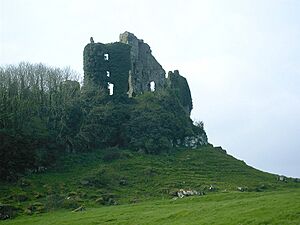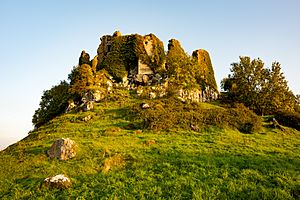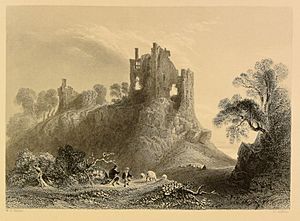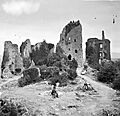Carrigogunnell facts for kids
Carrigogunnell Castle (Irish: Chairrge Ó gCoinneall) is an old Irish castle. It is located near the village of Clarina in County Limerick, right by the River Shannon.
This castle was built a very long time ago, at least in the early 1200s. It was badly damaged on purpose in September 1691. This happened after it was captured during the second siege of Limerick.
Contents
What Does Carrigogunnell Castle Look Like?
The castle stands on a high rock that came from a volcano. This spot gives it a great view over the low lands of Limerick and the River Shannon.
An expert named Westropp once said that the castle's design wasn't great for defense. He thought it was more like a strong home than a fortress built for big battles. The main gate on the south side was not well protected. It didn't have side towers, and its walls were not very thick.
The castle had a large outer area, about the size of one acre. This area was shaped a bit like a harp. There was a tower in the southwest corner. Most of the west wall was gone by 1908. A big two-story building was in the northeast corner. Some people think it might have been a chapel.
The inner, higher part of the castle was in the northwest corner. It had a long, two-story building along its west wall. This building showed signs of being built at different times. There was a strong tower, called a keep, in the very northwest corner. Next to it, there were rooms for living. There was also a tower and stairs on the south side. The buildings were made from well-cut local limestone, not from the rock of the hill itself.
The Castle's Keep
The Keep was over 50 feet tall and had five stories. It also had a spiral staircase. Around 1908, only the outer wall and parts of the southern wall were left. Its style suggests it was built in the 1300s or 1400s. East of the keep was a three-story house, likely from the 1500s.
What Does the Castle's Name Mean?
The name "Carraic Ui gConaing" is mentioned in old writings from 1209. These writings say that King John gave this land to Donchad Cairbreach O'Brien, who was a king in Ireland.
For a long time, the name has been linked to an Irish phrase meaning "rock of the candle." You can read more about this in the Legends section. In the time of Henry VIII, the castle was called "Carekogunyel." On old maps from the 1500s and 1600s, it was called names like "Carrig Gunning," "Carykgonyn," "Cargonin," or "Cargonian." The name "Carrigogunnel" has been used since at least 1536.
Some experts also believe the name comes from an old local tribe called the Ui Chonail Gabhra. However, there isn't much proof that this tribe actually controlled the land where the castle stands. Another idea is that the name Carrig-O-Gloinneal means "Rock of the O’Connells."
A Brief History of Carrigogunnell Castle
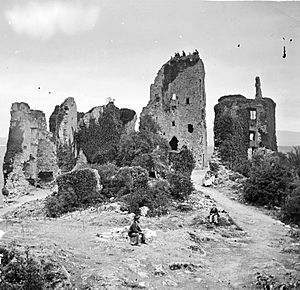
The castle is first mentioned in 1209. At that time, a place called Carrac Ui Conaing was given to Donnchad Cairbreach, the King of Thomond. Some old stories say that the Knights Templar built or lived in the castle, but there are no clear records of this.
For over 100 years, not much is known about the castle. Then, a part of the O'Briens family seemed to move into the area. They settled there and took over lands that were once owned by Normans. This might have happened around 1336. However, it's thought that the O'Briens who later owned Carrigogunnell Castle didn't get the place and build the castle much before 1450.
The castle first appears in important history records in 1536. Leonard Grey, 1st Viscount Grane, a powerful English leader, marched to "the very strong castle called Carekogunyel." He said it was "the key of all the county."
Changes in Ownership
According to a book about Limerick's history, the O'Connell Family also lived in the castle. They later gave it up to the Fitzgeralds.
Later, the owner, "Mat" (Mahon) O'Byrne, gave the castle to the government. He expected them to keep it themselves. But the government planned to give it to someone else. After some plotting, the castle ended up back with "Matthew's" guard. It was then attacked, and one of its towers was taken on August 22. The main tower surrendered the next morning. The guard, Edmond Cahill, and all his soldiers were taken to Limerick, put on trial, and punished.
The Crown, which was the English government, claimed the castle. They said the O'Briens held the land from an old lord whose lands now belonged to the Crown. Donough O'Bryne was given the castle, but he used his power unfairly and was removed. Mahon O'Byrne used to charge money for every barrel of wine or other goods brought to Limerick. Donough's son, Brian Duff, was later confirmed as the owner of the castle and most of the surrounding area.
The Castle's End
The castle was not used during the Wars of the Three Kingdoms (1640-1651). A Captain Wilson took it over and built a stable there. Its last owner, Donough Brien, wisely sold it to Michael Boyle, who later became an important church leader. At that time, the castle had its main building, a walled yard, a few small huts, and a place for catching salmon.
During the second siege of Limerick in the Williamite War in Ireland, about 150 soldiers for King James II were in the castle. In August 1691, a Dutch general named Godert de Ginckell sent soldiers and cannons to capture the castle. The soldiers inside gave up and were taken away as prisoners. Soon after, in September 1691, General de Ginckell ordered Carrigogunnell Castle to be destroyed. It was blown up.
Legends of Carrigogunnell
There's a famous story that before the castle was built, a scary old woman called 'Grana' lived on the rock at Carrigogunnell. She was said to be "huge and frightening." The legend says she would light a magic candle every night on the peak. Anyone who looked at it would die before the next sunrise.
In one version of the story, a hero named Regan, who was one of Finn's men, lifted this curse. He used a magic cap given to him by a magician. The story also says that a large, unusual stone in the area, known as the Clough-a-Regaun, was thrown by the hag at Regan as he escaped. According to a person who wrote down the tale in the 1800s, the name Carrigogunnel comes from this story, meaning "rock of the candle." Other versions of the story say that Saint Patrick was the one who stopped the hag.
Images for kids


